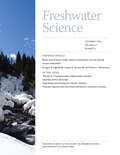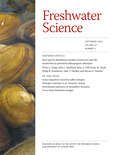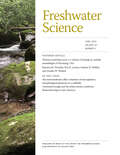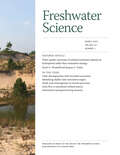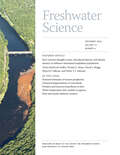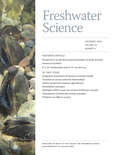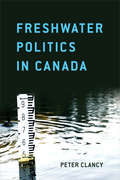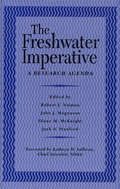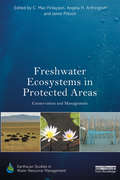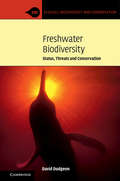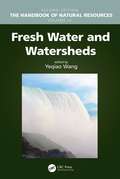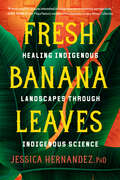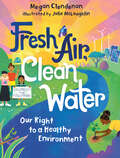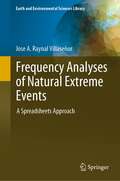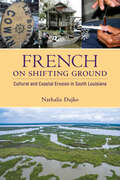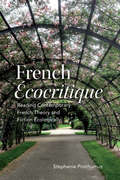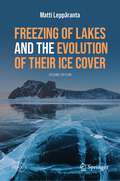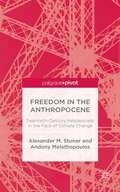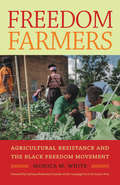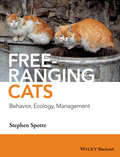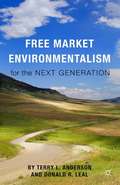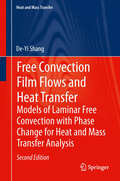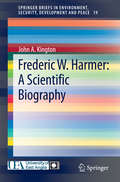- Table View
- List View
Freshwater Science, volume 43 number 1 (March 2024)
by Freshwater ScienceThis is volume 43 issue 1 of Freshwater Science. Freshwater Science (FWS) publishes articles that advance understanding and environmental stewardship of all types of inland aquatic ecosystems (lakes, rivers, streams, reservoirs, subterranean, and estuaries) and ecosystems at the interface between aquatic and terrestrial habitats (wetlands, riparian areas, and floodplains). The journal regularly features papers on a wide range of topics, including physical, chemical, and biological properties of lentic and lotic habitats; ecosystem processes; structure and dynamics of populations, communities, and ecosystems; ecology, systematics, and genetics of freshwater organisms, from bacteria to vertebrates; linkages between freshwater and other ecosystems and between freshwater ecology and other aquatic sciences; bioassessment, conservation, and restoration; environmental management; and new or novel methods for basic or applied research.
Freshwater Science, volume 42 number 4 (December 2023)
by Freshwater ScienceThis is volume 42 issue 4 of Freshwater Science. Freshwater Science (FWS) publishes articles that advance understanding and environmental stewardship of all types of inland aquatic ecosystems (lakes, rivers, streams, reservoirs, subterranean, and estuaries) and ecosystems at the interface between aquatic and terrestrial habitats (wetlands, riparian areas, and floodplains). The journal regularly features papers on a wide range of topics, including physical, chemical, and biological properties of lentic and lotic habitats; ecosystem processes; structure and dynamics of populations, communities, and ecosystems; ecology, systematics, and genetics of freshwater organisms, from bacteria to vertebrates; linkages between freshwater and other ecosystems and between freshwater ecology and other aquatic sciences; bioassessment, conservation, and restoration; environmental management; and new or novel methods for basic or applied research.
Freshwater Science, volume 42 number 3 (September 2023)
by Freshwater ScienceThis is volume 42 issue 3 of Freshwater Science. Freshwater Science (FWS) publishes articles that advance understanding and environmental stewardship of all types of inland aquatic ecosystems (lakes, rivers, streams, reservoirs, subterranean, and estuaries) and ecosystems at the interface between aquatic and terrestrial habitats (wetlands, riparian areas, and floodplains). The journal regularly features papers on a wide range of topics, including physical, chemical, and biological properties of lentic and lotic habitats; ecosystem processes; structure and dynamics of populations, communities, and ecosystems; ecology, systematics, and genetics of freshwater organisms, from bacteria to vertebrates; linkages between freshwater and other ecosystems and between freshwater ecology and other aquatic sciences; bioassessment, conservation, and restoration; environmental management; and new or novel methods for basic or applied research.
Freshwater Science, volume 42 number 2 (June 2023)
by Freshwater ScienceThis is volume 42 issue 2 of Freshwater Science. Freshwater Science (FWS) publishes articles that advance understanding and environmental stewardship of all types of inland aquatic ecosystems (lakes, rivers, streams, reservoirs, subterranean, and estuaries) and ecosystems at the interface between aquatic and terrestrial habitats (wetlands, riparian areas, and floodplains). The journal regularly features papers on a wide range of topics, including physical, chemical, and biological properties of lentic and lotic habitats; ecosystem processes; structure and dynamics of populations, communities, and ecosystems; ecology, systematics, and genetics of freshwater organisms, from bacteria to vertebrates; linkages between freshwater and other ecosystems and between freshwater ecology and other aquatic sciences; bioassessment, conservation, and restoration; environmental management; and new or novel methods for basic or applied research.
Freshwater Science, volume 42 number 1 (March 2023)
by Freshwater ScienceThis is volume 42 issue 1 of Freshwater Science. Freshwater Science (FWS) publishes articles that advance understanding and environmental stewardship of all types of inland aquatic ecosystems (lakes, rivers, streams, reservoirs, subterranean, and estuaries) and ecosystems at the interface between aquatic and terrestrial habitats (wetlands, riparian areas, and floodplains). The journal regularly features papers on a wide range of topics, including physical, chemical, and biological properties of lentic and lotic habitats; ecosystem processes; structure and dynamics of populations, communities, and ecosystems; ecology, systematics, and genetics of freshwater organisms, from bacteria to vertebrates; linkages between freshwater and other ecosystems and between freshwater ecology and other aquatic sciences; bioassessment, conservation, and restoration; environmental management; and new or novel methods for basic or applied research.
Freshwater Science, volume 41 number 4 (December 2022)
by Freshwater ScienceThis is volume 41 issue 4 of Freshwater Science. Freshwater Science (FWS) publishes articles that advance understanding and environmental stewardship of all types of inland aquatic ecosystems (lakes, rivers, streams, reservoirs, subterranean, and estuaries) and ecosystems at the interface between aquatic and terrestrial habitats (wetlands, riparian areas, and floodplains). The journal regularly features papers on a wide range of topics, including physical, chemical, and biological properties of lentic and lotic habitats; ecosystem processes; structure and dynamics of populations, communities, and ecosystems; ecology, systematics, and genetics of freshwater organisms, from bacteria to vertebrates; linkages between freshwater and other ecosystems and between freshwater ecology and other aquatic sciences; bioassessment, conservation, and restoration; environmental management; and new or novel methods for basic or applied research.
Freshwater Science, volume 39 number 4 (December 2020)
by Freshwater ScienceThis is volume 39 issue 4 of Freshwater Science. Freshwater Science (FWS) publishes articles that advance understanding and environmental stewardship of all types of inland aquatic ecosystems (lakes, rivers, streams, reservoirs, subterranean, and estuaries) and ecosystems at the interface between aquatic and terrestrial habitats (wetlands, riparian areas, and floodplains). The journal regularly features papers on a wide range of topics, including physical, chemical, and biological properties of lentic and lotic habitats; ecosystem processes; structure and dynamics of populations, communities, and ecosystems; ecology, systematics, and genetics of freshwater organisms, from bacteria to vertebrates; linkages between freshwater and other ecosystems and between freshwater ecology and other aquatic sciences; bioassessment, conservation, and restoration; environmental management; and new or novel methods for basic or applied research.
Freshwater Politics in Canada
by Peter ClancyFreshwater is in great supply across much of Canada. However, competing and changing demands on its use are leading to ever more complex political arrangements. This volume offers an integrated survey of that complexity, combining historical and contemporary cases in a conceptually-informed exploration of water politics. It offers a set of tools, frameworks, and applications that enable readers to recognize and explore the political dimensions of freshwater. The opening chapters introduce core concepts such as power, organized interests, knowledge systems, and the state. They are followed by chapters discussing freshwater subsectors including fisheries, irrigation, flood control, hydropower, and groundwater. A series of topical themes is addressed, including salmon conservation, Aboriginal water interests, hydraulic fracturing, regulatory revisions, and interjurisdictional management. A final section explores emerging trends in freshwater governance. While river catchments are not always the principal denominator in discussions of water politics, they do provide a primary frame of reference for this book. A watershed case study accompanies each chapter. This watershed grounding is intended to encourage readers to turn their attention to local and regional conditions.
The Freshwater Imperative: A Research Agenda
by Diane M. Mcknight Robert J. Naiman John J. Magnuson Jack A. Stanford Kathryn D. SullivanThis volume summarizes the two-year effort of a working group of leading aquatic scientists sponsored by NSF, EPA, NASA, TVA, and NOAA to identify research opportunities and frontiers in freshwater sciences for this decade and beyond. The research agenda outlined focuses on issues of water availability, aquatic ecosystem integrity, and human health and safety. It is a consensus document that has been endorsed by all of the major professional organizations involved with freshwater issues.
Freshwater Ecosystems in Protected Areas: Conservation and Management (Earthscan Studies in Water Resource Management)
by C. Max Finlayson Angela H. Arthington Jamie PittockFreshwater ecosystems have the greatest species diversity per unit area and many endangered species. This book shows that, rather than being a marginal part of terrestrial protected area management, freshwater conservation is central to sustaining biodiversity. It focuses on better practices for conserving inland aquatic ecosystems in protected areas, including rivers, wetlands, peatlands, other freshwater and brackish ecosystems, and estuaries. The authors define inland aquatic ecosystems, showing just how diverse and widespread they are. They examine the principles and processes that are essential for the conservation of freshwater ecosystems and aquatic species. Major categories of threats to freshwater ecosystems and the flow-on implications for protected area design are described. Practical case studies are used to illustrate principles and practices applied around the world. Specific management needs of the main types of freshwater ecosystems are considered, as well as the management of freshwaters in the broader landscape, showing how natural resource governance processes can be harnessed to better manage freshwater biodiversity. The book offers commentary on how to adapt freshwater conservation practices to climate change and ends with an insightful synthesis.
Freshwater Biodiversity: Status, Threats and Conservation (Ecology, Biodiversity and Conservation)
by David DudgeonGrowing human populations and higher demands for water impose increasing impacts and stresses upon freshwater biodiversity. Their combined effects have made these animals more endangered than their terrestrial and marine counterparts. Overuse and contamination of water, overexploitation and overfishing, introduction of alien species, and alteration of natural flow regimes have led to a 'great thinning' and declines in abundance of freshwater animals, a 'great shrinking' in body size with reductions in large species, and a 'great mixing' whereby the spread of introduced species has tended to homogenize previously dissimilar communities in different parts of the world. Climate change and warming temperatures will alter global water availability, and exacerbate the other threat factors. What conservation action is needed to halt or reverse these trends, and preserve freshwater biodiversity in a rapidly changing world? This book offers the tools and approaches that can be deployed to help conserve freshwater biodiversity.
Fresh Water and Watersheds
by Yeqiao WangAuthored by world-class scientists and scholars, The Handbook of Natural Resources, Second Edition, is an excellent reference for understanding the consequences of changing natural resources to the degradation of ecological integrity and the sustainability of life. Based on the content of the bestselling and CHOICE-awarded Encyclopedia of Natural Resources, this new edition demonstrates the major challenges that the society is facing for the sustainability of all well-being on the planet Earth. The experience, evidence, methods, and models used in studying natural resources are presented in six stand-alone volumes, arranged along the main systems of land, water, and air. It reviews state-of-the-art knowledge, highlights advances made in different areas, and provides guidance for the appropriate use of remote sensing and geospatial data with field-based measurements in the study of natural resources. Volume 4, Fresh Water and Watersheds, covers fresh water and watersheds, their health and conservation, protection, and management. Organized for ease of reference, it provides fundamental information on groundwater storage, water quality, supply and balance, and water resource vulnerability. New in this edition are discussions on water footprint assessment, water surface dynamics, and water management on a global scale. Understanding the conditions of watersheds is crucial for restoring areas with degraded water quality as well as protecting healthy waters from emerging problems. This volume demonstrates the key processes, methods, and models used through several practical case studies from around the world. Written in an easy-to-reference manner, The Handbook of Natural Resources, Second Edition, as individual volumes or as a complete set, is an essential reading for anyone looking for a deeper understanding of the science and management of natural resources. Public and private libraries, educational and research institutions, scientists, scholars, and resource managers will benefit enormously from this set. Individual volumes and chapters can also be used in a wide variety of both graduate and undergraduate courses in environmental science and natural science at different levels and disciplines, such as biology, geography, earth system science, and ecology.
Fresh Banana Leaves: Healing Indigenous Landscapes through Indigenous Science
by Jessica HernandezAn Indigenous environmental scientist breaks down why western conservationism isn't working--and offers Indigenous models informed by case studies, personal stories, and family histories that center the voices of Latin American women and land protectors.Despite the undeniable fact that Indigenous communities are among the most affected by climate devastation, Indigenous science is nowhere to be found in mainstream environmental policy or discourse. And while holistic land, water, and forest management practices born from millennia of Indigenous knowledge systems have much to teach all of us, Indigenous science has long been ignored, otherized, or perceived as "soft"--the product of a systematic, centuries-long campaign of racism, colonialism, extractive capitalism, and delegitimization. Here, Jessica Hernandez--Maya Ch'orti' and Zapotec environmental scientist and founder of environmental agency Piña Soul--introduces and contextualizes Indigenous environmental knowledge and proposes a vision of land stewardship that heals rather than displaces, that generates rather than destroys. She breaks down the failures of western-defined conservatism and shares alternatives, citing the restoration work of urban Indigenous people in Seattle; her family's fight against ecoterrorism in Latin America; and holistic land management approaches of Indigenous groups across the continent. Through case studies, historical overviews, and stories that center the voices and lived experiences of Indigenous Latin American women and land protectors, Hernandez makes the case that if we're to recover the health of our planet--for everyone--we need to stop the eco-colonialism ravaging Indigenous lands and restore our relationship with Earth to one of harmony and respect.
Fresh Air, Clean Water: Our Right to a Healthy Environment (Orca Think #4)
by Megan ClendenanEveryone depends on clean air to breathe, safe water to drink and healthy soil for growing food. But what if your drinking water is dangerous, your air is polluted and your soil is toxic? What can you do about that? Do you have the right to demand change? Fresh Air, Clean Water: Defending Our Right to a Healthy Environment explores the connections between our environment and our health, and why the right to live in a healthy environment should be protected as a human right. The book features profiles of kids around the world who are taking action and important environmental rights court cases. Hear the powerful stories of those fighting for change.
Frequency Analyses of Natural Extreme Events: A Spreadsheets Approach (Earth and Environmental Sciences Library)
by Jose A. Raynal VillaseñorThis book is of paramount importance in the fields of engineering and applied sciences, given that through the values obtained by these procedures, many structures, like spillways of dams and highway culverts, are designed and constructed. The main aim of this book is to provide procedures for implementing many probability distribution functions, all of them based on using a standard and a common computational application known as Excel, which is available to any personal computer user. The computer procedures are given in enough detail, so readers can develop their own Excel worksheets. All the probability distribution functions in the book have schemes to estimate its parameters, quantiles, and confidence limits through the methods of moments and maximum likelihood.
French on Shifting Ground: Cultural and Coastal Erosion in South Louisiana (America's Third Coast Series)
by Nathalie DajkoIn French on Shifting Ground: Cultural and Coastal Erosion in South Louisiana, Nathalie Dajko introduces readers to the lower Lafourche Basin, Louisiana, where the land, a language, and a way of life are at risk due to climate change, environmental disaster, and coastal erosion. Louisiana French is endangered all around the state, but in the lower Lafourche Basin the shift to English is accompanied by the equally rapid disappearance of the land on which its speakers live. French on Shifting Ground allows both scholars and the general public to get an overview of how rich and diverse the French language in Louisiana is, and serves as a key reminder that Louisiana serves as a prime repository for Native and heritage languages, ranking among the strongest preservation regions in the southern and eastern US. Nathalie Dajko outlines the development of French in the region, highlighting the features that make it unique in the world and including the first published comparison of the way it is spoken by the local American Indian and Cajun populations. She then weaves together evidence from multiple lines of linguistic research, years of extensive participant observation, and personal narratives from the residents themselves to illustrate the ways in which language—in this case French—is as fundamental to the creation of place as is the physical landscape. It is a story at once scholarly and personal: the loss of the land and the concomitant loss of the language have implications for the academic community as well as for the people whose cultures—and identities—are literally at stake.
French 'Ecocritique': Reading French Theory and Fiction Ecologically
by Stephanie PosthumusFrench Écocritique is the first book-length study of the culturally specific ways in which contemporary French literature and theory raise questions about nature and environment. Stephanie Posthumus’s ground-breaking work brings together thinkers such as Guattari, Latour, and Serres with recent ecocritical theories to complicate what might otherwise become a reductive notion of "French ecocriticism." Working across contemporary philosophy and literature, the book defines the concept of the ecological as an attentiveness to specific nature-culture contexts and to a text’s many interdiscursive connections. Posthumus identifies four key concepts, ecological subjectivity, ecological dwelling, ecological politics, and ecological ends, for changing how we think about human-nature relations. French Écocritique highlights the importance of moving beyond canonical ecocritical texts and examining a diversity of cultural and literary traditions for new ways of imagining the environment.
Freezing of Lakes and the Evolution of Their Ice Cover (Springer Praxis Books)
by Matti LeppärantaThis book updates the first edition for the status of knowledge in the physics of lake ice and the interactions between the ice cover and the liquid water underneath. Since the first edition was written in 2013, there has been a lot of progress in the field, in particular concerning environmental questions and the impact of climate change. Life conditions in ice-covered lakes and practical matters are now brought more into the picture so that the revision also properly serves as a handbook for applications. The author has worked widely with boreal lakes, polar lakes and Central Asian lakes that provides a wide geographical spectrum.Chapter 1 gives a brief overview and presents the research fields. The second chapter contains the classification of ice-covered lakes and observation techniques, especially remote sensing. In Chapter 3, the structure and properties of lake ice are presented including optics and geochemistry. Ice growth and melting are treated in Chapter 4, while the following chapter focuses on ice mechanics with applications to traffic on ice and ice loads. Chapter 6 goes into the exotic environment of pro-glacial lakes. Chapter 7 contains the stratification and circulation of the water body beneath lake ice, Chapter 8 presents the winter ecology of freezing lakes and discusses the lake ice interface toward the society, and Chapter 9 summarizes the climate change impact on lake ice seasons. The book ends into a brief closing chapter and list of references. Research problems for student learning are listed throughout the book. Annexes are included to provide numerical data of constants and standard formulae to help practical calculations and student tasks.Lake ice closely interacts with human living conditions, but people have learnt to live with that and to utilize the ice. In the present time this is true for on-ice traffic and recreation activities. Ice fishing has become a widely enjoyed hobby, and winter sports such as skiing, skating, and ice sailing are popular activities on frozen lakes. The lake ice response to eventual climate warming would appear as a shortening of the ice season due to the increasing air temperature and also as changing of the quality of the ice seasons via changes in ice thickness and structure. The book gives the whole story of lake ice into a single volume. The second, revised edition updates the content based on recent progress in winter limnology and ice physics research and applications. The author has contributed to lake ice research since the 1980s. In particular, his topics have been lake ice structure and thermodynamics, light transfer in ice and snow, ice mechanics in large lakes, and lake ice climatology. Mathematical modeling of ice growth, drift, and decay are covered in this research.
Freedom in the Anthropocene: Twentieth-Century Helplessness in the Face of Climate Change
by Alexander M. Stoner Andony MelathopoulosFreedom in the Anthropocene illuminates the Anthropocene from the perspective of critical theory. The authors contextualize our current ecological predicament by focusing on the issues of history and freedom and how they relate to our present inability to render environmental threats and degradation recognizable and surmountable.
Freedom Home - Paying Energy Bills is Optional and may save your Life!
by P. Stephen O’learyImagine a World where you have NO electricity or gas bills? Nada! Zilch! Zero! Imagine a home that uses nature to heat and cool your home? At no cost! Imagine a healthy home where the air quality is pristine that toxins, dustmites, mould cannot live in and condensation or harmful VOCs are non-existent that can harm the health of your family? Imagine growing your own vegetables with water you have captured and you home also having a hot water service costing nothing to run? Imagine a home 20-21° constantly, 24/7? Imagine cooking in a kitchen with the latest technology? Imagine your contribution to a cleaner world? Imagine?
Freedom Farmers: Agricultural Resistance and the Black Freedom Movement (Justice, Power, and Politics)
by Monica M. WhiteIn May 1967, internationally renowned activist Fannie Lou Hamer purchased forty acres of land in the Mississippi Delta, launching the Freedom Farms Cooperative (FFC). A community-based rural and economic development project, FFC would grow to over 600 acres, offering a means for local sharecroppers, tenant farmers, and domestic workers to pursue community wellness, self-reliance, and political resistance. Life on the cooperative farm presented an alternative to the second wave of northern migration by African Americans--an opportunity to stay in the South, live off the land, and create a healthy community based upon building an alternative food system as a cooperative and collective effort.Freedom Farmers expands the historical narrative of the black freedom struggle to embrace the work, roles, and contributions of southern black farmers and the organizations they formed. Whereas existing scholarship generally views agriculture as a site of oppression and exploitation of black people, this book reveals agriculture as a site of resistance and provides a historical foundation that adds meaning and context to current conversations around the resurgence of food justice/sovereignty movements in urban spaces like Detroit, Chicago, Milwaukee, New York City, and New Orleans.
Free-ranging Cats
by Stephen SpotteFeral and stray domestic cats occupy many different habitats. They can resist dehydration for months by relying exclusively on the tissue water of their prey allowing them to colonize remote deserts and other inhospitable places. They thrive and reproduce in humid equatorial rainforests and windswept subantarctic islands. In many areas of the world feral cats have driven some species of birds and mammals to extinction and others to the edge, becoming a huge conservation concern. With the control of feral and stray cats now a top conservation priority, biologists are intensifying efforts to understand cat behaviour, reproductive biology, use of space, intraspecies interaction, dietary requirements, prey preferences, and vulnerability to different management strategies. This book provides the most comprehensive review yet published on the behavior, ecology and management of free-ranging domestic cats, whether they be owned, stray, or feral. It reviews management methods and their progress, and questions several widely accepted views of free-ranging cats, notably that they live within dominance hierarchies and are highly social. Insightful and objective, this book includes: a functional approach, emphasizing sensory biology, reproductive physiology, nutrition, and space partitioning; clear treatment of how free-ranging cats should be managed; extensive critical interpretation of the world's existing literature; results of studies of cats in laboratories under controlled conditions, with data that can also be applied to pet cats. Free-ranging Cats: Behavior, Ecology, Management is valuable to ecologists, conservation scientists, animal behaviorists, wildlife nutritionists, wildlife biologists, research and wildlife veterinarians, clinical veterinarians, mammalogists, and park and game reserve planners and administrators.
Free Market Environmentalism for the Next Generation
by Terry L. Anderson Donald R. LealThis book provides a vision for environmentalism's future, based on the success of environmental entrepreneurs around the world. The work provides the next generation of environmental market ideas and the chapters are co-authored with young scholars and policy analysts who represent the next generation of environmental leaders.
Free Convection Film Flows and Heat Transfer
by De-Yi ShangThis book presents recent developments in our systematic studies of hydrodynamics and heat and mass transfer in laminar free convection, accelerating film boiling and condensation of Newtonian fluids, as well as accelerating film flow of non-Newtonian power-law fluids (FFNF). These new developments provided in this book are (i) novel system of analysis models based on the developed New Similarity Analysis Method; (ii) a system of advanced methods for treatment of gas temperature- dependent physical properties, and liquid temperature- dependent physical properties; (iii) the organically combined models of the governing mathematical models with those on treatment model of variable physical properties; (iv) rigorous approach of overcoming a challenge on accurate solution of three-point boundary value problem related to two-phase film boiling and condensation; and (v) A pseudo-similarity method of dealing with thermal boundary layer of FFNF for greatly simplifies the heat-transfer analysis and numerical calculation. A system of practical application equations on heat and mass transfer are provided in each chapter, which are formulated based on the rigorous numerical solutions with consideration of variable physical properties. In addition, in the second edition, other new research developments are further included on resolving an even big challenge associated with investigations of laminar free film condensation of vapour-gas mixture. They involve the novel methods for treatment of concentration- and temperature- dependent physical properties of vapour-gas mixture, and for rigorous solution of interfacial vapour saturation temperature, which have lead to rigorous analysis and calculation results on two-phase film flow velocity, temperature, and concentration fields, as well as condensate heat and mass transfer.
Frederic W. Harmer: A Scientific Biography
by John A. KingtonComprising the first definitive account of the geological and palaeometeorological studies made by the British geologist, Frederic W. Harmer (1835-1924) this book contributes a previously missing chapter to the history of science. The main objective of the author is to ensure that the scientific work of Harmer, which unfortunately has been widely neglected or forgotten, becomes more generally known and acknowledged. The balance of this deficiency will be redressed by bringing to light in this volume his contributions to the history of science to an audience of academic and lay readers of the current literature.

